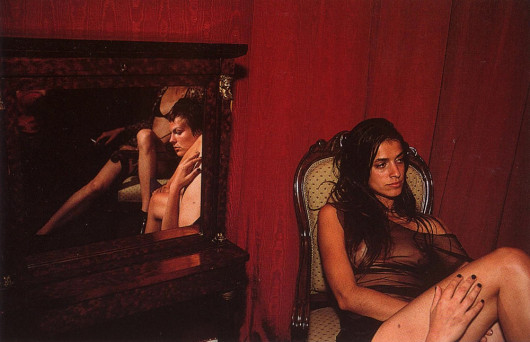
Nan Goldin
Gloucester : When shall I come to the top of that same hill?
Edgar: You do climb up it now: look, how we labour.
Gloucster: Methinks the ground is even.
Edgar: Horrible steep.
Hark, do you hear the sea?
Gloucster: No, truly.
Shakespeare, King Lear
A few thoughts on space, and on the idea of teaching playwriting. I don’t think its possible for writing courses, in theatre at least, to get things more wrong. This is born out by the quality of the plays coming out of University programs, and/or those being developed in big institutional theatres every year. The first thing that seems to have been forgotten is that theatre occupies, and simultaneously, creates a space. A place. I wanted to just expand a tiny bit on how architecture intersects with playwriting. *Note: a person is a playwright, but the acting of writing a play is playwriting. Though I might make an argument for playwrighting to be honest.* Anyway. there are things of a primal mimetic nature that are connected to architecture. At the quirky but very interesting blog Someone has Built it Before, there is a discussion, not very long, on ‘conscious inspiration’. The connections between Greek temple building, le Corbusier, Scarpa and Stephen Holl, for example. The fascination with extrusions. The interesting part, though, is in the way certain spaces touch on very basic ideas of navigation through the world. Le Corbusier’s Unite d’Habitation, finished in 1952, is placed on pilotis; stilts. This has recently been used by Peter Zumthor’s LACMA design. Couple this to the idea of the raised beam, and something basic and seductive is going on. There are two primal elements at work in defining space. The Zumthor design uses specific entrances to the elevated level, ramps, which give a quality much like walking in a forest. You discover the way out. But it seems to take on another quality by virtue of being elevated. Jean Nouval’s Quai Branley Museum is another version of this same idea. There is a magical aspect to entering the forest. But there are paradoxes too, to buildings such as Unite d’ Habitation, which also was probably part of the inspiration for Godard’s Alphaville. The roof resembles nothing so much as a Cruise ship. It is, still, however, a pretty magisterial building.
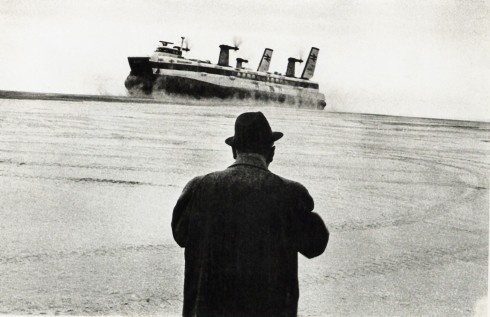
Josef Koudelka
The compulsive repetitive nature of mass marketing has gone a long ways in the training of perception. But it is the mystifying of repetition, the pretense is of difference. And this seems crucial. The liberal white class, the people who run institutional theatre, and University programs in writing, believe largely in a marketed reality within which stories of individualism can be played out. Clear cut the forest, the better to inspect ‘psychology’ as it is operative in each ‘character’. This links also to my last post and this idea of mastery. You cannot master the forest, without mostly cutting it down. The sense of space: that theatrical space, linked to an ‘off stage’, to an elsewhere that is unconscious, is by its very nature submissive. The submission allows for that walk in the forest. That walk is creative and it also the disovery of a path. The Situationists used to say, get a map of Berlin and use it to navigate yourself around Milan.
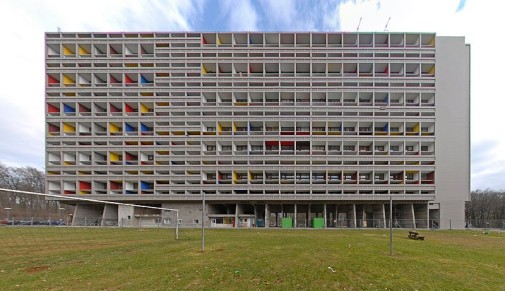
Unite d’ Habitation. Le Corbusier architect, 1952
There is a resurrgent racism, and it is almost always coupled to a bullying tone of authoritarian rhetoric. It takes the form of Zizek’s openly racist clown show, or Laurie Penny’s elitist hectoring and moralizing (per the bottom of this post) the rancid elitism of Bhaskar Shunkara, or mainstream reactionaries like Nick Kristoff et al, and culturally, in places like The New Yorker, where Emily Nussbaum is regressive feminist du jour. But what struck me this week was the bullying; when I happened to read THREE different postings in social media with links to the Nussbaum review of the new HBO show, True Detective. Now, all three postings also prefaced their posting of Nussbaum’s review with almost identical comments “I love the show, but of course she is right”. How can that be? How can Nussbaum be right, and you (all were women) love the show? The answer is, writers such as Nussbaum tend toward a tone of tacit bossiness, its the sound of a junior high school girl’s principle. Detention for you if you don’t denigrate this show. What is stunningly obvious is that 99% of what is on network or cable TV could be called misogynist. And in most cases, you’d be correct. But in fact I dont think True Detective really is. But thats not the reason its being attacked. Its being attacked for two reasons. The first is that the show is about poverty. The second is that its about the psychic injuries men suffer when they cannot step outside the systems of domination and emotional crippling that the authority structure imposes. School, military, employment. The hierarchies of authority. The men are damaged, all of them. A culture of punishment in which masculinity is defined by brutality. What writers like Nussbaum do (and look, Nussbaum is a moron, who loved Girls and Orange is the New Black), and Laurie Penny and a few others, both left and right, is to appeal to women’s rights, to point to gender inequality while simultaneously validating the authority structure that created those inequalities. Hillary for President. Kathryn Bigelow as leader of women breaking through in directing. Lena Dunham is a genius. Ok, now I mention this here because the writer of True Detective is well aware of the deformation of male psyches, and he is a kid from Lousiana, and a provincial college down there, not Harvard. His sensibility grates on Emily Nussbaum. Lena Dunham’s doesnt.
http://insidetv.ew.com/2014/02/27/true-detective-nic-pizzolatto-season-1/

Dr Schnabel Von Rom…The Plague Doctor.
But also these critical hacks are always white. White and University educated. ALWAYS. There is an aspect to this so blatently racist as to induce momentary catatonia. When I posted about MFA writing programs, and then a suggestion about the real narrative of US culture in the 20th century, it ends up in this 21st century cultural backwash, or mental septic tank overflow that is Lena Dunham and Emily Nussbaum. Or Laurie Penny or Natasha Lennard, or Kristoff, or all of the New York Times, et al. But in this case, its white educated (sic) feminism. Dealing with white people problems. And how will white privilege deal with underclass complaints. The problem of course, is that there is going to be another sort of backlash of white male posturing. As much as I loved what Russell Brand said on the Paxman show, one could see the not so subtle misogyny of the many male journalists on the left creeping into the discourse.
Identify the enemy.
Now, here is Nussbaum and Dunham.
http://fora.tv/2012/10/07/Girls_Power_Lena_Dunham_Talks_with_Emily_Nussbaum_/Inspiration_for_Dunhams_Girls_Real-Life_Bad_Dates
But to bring this back to ‘space’ and theatre. There is an acute insensitivity in mainstream institutional critics. And it manifests itself in a need for clear message, for explanation. But the class element in unmistakable as well, and hence, writing for the theatre has become about fullfulling the criteria set by places like The New Yorker. If you want to be an artist, step number one might be to stop reading that crap.
Now Le Corbusier saw architecture in terms of the cosmos, and the infinite. But he saw this project, the cosmic one, coming out of basic mimetic readings of, not JUST space, but space and the body.
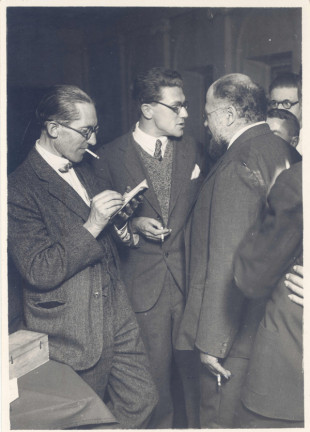
Le Corbusier, in USSR, 1928, on set of Eisenstein film
“Architecture is the masterly, correct and magnificent play of masses brought together in light. Our eyes are made to see forms in light; light and shade reveal these forms; cubes, cones, spheres, cylinders or pyramids are the great primary forms which light reveals to advantage; the image of these is distinct and tangible within us without ambiguity. It is for this reason that these are beautiful forms, the most beautiful forms.”
Le Corbusier
The forest again, ramps not stairs. For ramps link and stairs demarcate or seperate. For the playwriting student, the stage is a ceremony, but one in a forest. And it is one in which lurking off stage are the monsters and demons of ancient cartography.

Great Mosque, Xian China, 724 AD
One is walking, and the writer must know, am I walking down a circular corridor, or across an open plain? If you do not feel the difference, or know it, then you write junk. Now, without drawing any great theory from which artists or architects or buildings or plays provide one with that entrance to the forest, there are …lets stick with architects…some, who while facile and inventive, lack that sense of wonder. Daniel Libeskind, for me, is technically adroit, but souless. Carlos Scarpa was pure soul. Le Corbusier was soul, and so is Nouval and so was Kahn and Gaudi and Barragan. Richard Meier is the plague doctor of architects, so is Norman Foster and Philip Johnson. The playwright must know if a voice is generated by its hiddeness, but its latent possibility to speak in the light, and must know which direction the sun rises. Termites know, ants know. They construct their huge mounds, homes, always facing the sunrise, and in line with its arc or descent. Playwright as termite.
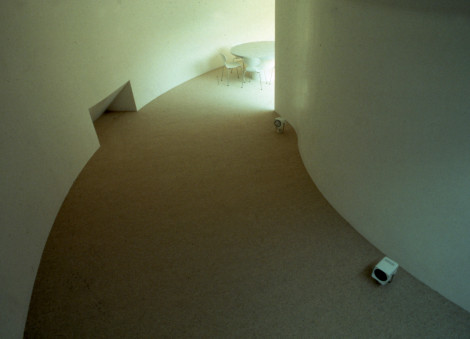
Toyo Ito, White House
When an actor speaks, he or she is doing several things at once. The words belong to the playwright, who is then immedietly the ghost, he who is haunting. A phantom analysand. The actor is stripping naked. He/she is forgetting, through the process of remembering. Only that constant repetition of rehearsal can achieve the right kind of forgetting. A specific kind of repetition. This is a tricky topic, and without wanting to sound cute, there are kinds of forgetting. And some are permenent, and some are historical. But some are a kind of satori. For they are really remembering. The actor remembers his lines at the expense of his soul. The actor remembers ‘the play’, forgets himself, and within that remembering of ‘the play’, the psychological must be forgotten. That is the sacrifice. He or she gets it back. Sort of. In film, you can see the camera wears down, grinds down the actor. The image becomes blurred around the edges. Its not possible, for example, to get certain movie stars in focus as they age (having nothing to do with soft focus), Jack Nicholson is out of focus. Forever. The camera is bad for people, if they are exposed to it for too long. I really believe this.

Max Ernst
The actor is performing a ritual, and within that ritual is a narrative. But its just gossip if there is no ritual. Id say 90% of American theatre today is skits and gossip. It is narrative without ritual or history, and without ‘space’. Its either fun or sentimental. Perhaps theatre artists have just been beaten down so long they are willing to roll over and pant for liver treats. I don’t know. Playwright as puppy. The writing of text, for theatre, which is almost only dialogue, means that a certain weird balance must take place between ritual, psychology (character), the obliteration of psychology, and space. All are impacted by history, meaning memory. But there is a truth, in Worringer’s claim of creative production under stability (Ancient Egypt) and under anxiety, or trauma. This is the fulcrum on which ideas of realism teeter and its the trickiest part of this. Our aesthetic expression, under the anxiety of advanced capital, for the era of modernism, has been to interrogate versimilitude. The society that is not secure with its collective identity. The Pharaonic world of Egypt, for example, reiterated the same thing, the same hard edged geometry, again and again. The rise of landscape painting, and the 13 century invention (well, reinvention) of 3 pt perspective, seemed to suggest a society happy to see its own reflection. Its own perception reflected back upon itself. The discussion of perspective is worth a whole posting I think. Chinese painting in the classical era invented an entirely other perspective.
In a sense, however, I suspect contemporary writers probably needn’t worry about it. For the writer will channel what he or she channels. No amount of preperation will help that. In fact, preparation should only mean staring at works or views or vistas that evoke awe. There are some photos…like the one below, of Le Corbusier’s Assembly building in Chandigarh, India, that do this for me. I’ve posted others, Kahn’s Bangladesh government complex, Poelzig’s modest acid factory in Lublin, and in person I spent a month watching the river pass in Benares, and walked the square in Mexico City, or etc. Everyone finds things. I can sit in the Pollack room of the Modern and waste a day. Of course, some performances do this too. First time, at the age of 12, when I saw a production of Godot. I knew things had been kept from me. So, the first step to write is to be in space. Place. Now, you can ride trains and be more situated than almost anywhere else. The train is always relating itself, in constant motion, to the horizon. The sea does that. Ride a freighter, a ferry, any ship, and the horizon narrates something.
Here is an interesting short piece at the Someone Has Built It Before blog: http://archidialog.com/tag/louis-kahn/
It is worth noting the difference in the Louis Sullivan bank building (near bottom of page) and Kahn’s work. Siza is terrific and so is Botta, who I become increasingly attracted to, and how Hadid seems, somehow, not as soulfull as I want her to be. Imitation and not inspiration. But perhaps I’m wrong, I’m not sure.

Palace of Assembly, Chandigarh. Le Corbusier architect
Maybe it reminds me of being in India. Or the sense of that reflection in the pool, for you know its hot. Things reflect off water differently when its very hot. India has very unique horizons, too. They are imperfect, somehow. India is miraculous. And Indians will always remind you, it is ‘old’.
So there are all these things, but they include, too, a political understanding. If you cannot grasp the bad theatre of American politics, or see and hear the lies everywhere, then you cant be an artist or writer. Go home. Take up something useful. Like plumbing. All socities need more plumbers.

Termite hill, Somalia
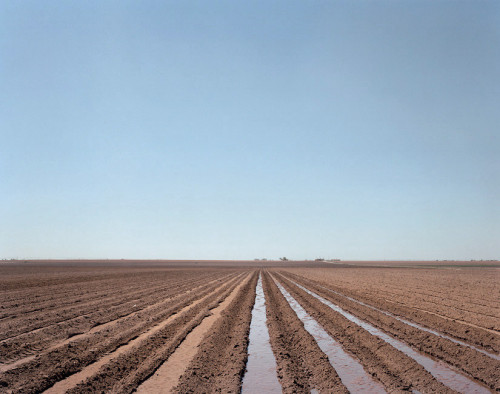
Levelland Texas, Peter Brown photography.
The end of the craftsmen revolt that reached its most articulate point with William Morris, was now over. The role of sociologists grew, of work enviroment planners, and even artists, were being directed at goals of efficiency and also hygiene and cleanliness. But this was in the service of the owners of the means of production. The aesthetics of efficiency seeped into consciousness. This is the front edges of what would become marketing analysis. Color coding in the factory, changed the experience of color itself. And certainly space was altered. Of course it was already altered by the Industrial Revolution, but now it was being rationalized. Mass produced houses employed color and material variety to create an illusion of spatial change. Masonite, Ferro-enamel, and Stran-steel were used as nothing more than decoration. Jackson points out three significant changes in house building in the U.S.: the integration of a garage into the facade of the single family home, the chimney, divorced from kitchen utility or heating, became one of the principle symbols of domesticity, and the celler was eliminated (thereby increasing the horizontality of the layout). There was additionally, the rise of the ‘interior decorator’. It was cheaper to remodel than rebuild.
This was the illusion of progress, though in some respects, of course, it was an improvement. But the complexity of that topic exceeds this posting. For what was clear was that a new psychology of work was being sold to the working class. But not just to the working class, for these principles affected mass perception. And this belief in progress and efficiency effected something else, and that was the nature of our mimetic process with objects of contemplation. Entertainment was progressive, and so it is today. When one today reads bad reviews of new film or TV, the word ‘solemnity’ is one used as the highest perjoritive. Solemnity is a failure of entertainment.

Joseph Albers
Solemn means no fun. More, it means ‘art’ should be taken seriously. Taking culture seriously is a no-no. Of course, the very first intention in writing is seriousness. Not grave, not ponderous, but serious.
In his book, The Architecture of Failure, Douglas Murphy writes:
“The multitudes of spindly atria and oxidized curtain wall of the last generation of office blocks built all over the world are very much the children of Foster and Rogers, as are the endless sterilizations of once interesting spaces in the name of regeneration. The high-tech spaces we walk through now are fit only for the smiling ghosts of computer visualizations, a purgatory of ‘aspirational but accessible’ restaurants and bars, ‘media-walls’ and ‘public art’ of unremitting dreariness. Where socialists and radicals could once read within the language of explicit engineering signs of redemption or change, the post High-Tech architecture in our cities has no such associations: it may not be historicist, like the postmodern architecture of the neo-liberal turn in the 1980s, but rather its anaesthetized formal language is a perfect complement to the hollowed out shell of social democracy.”
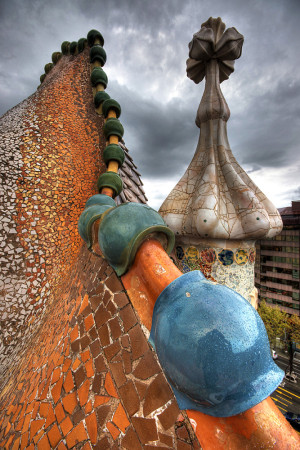
Casa Batillo, roof. Antonio Gaudi architect
This is the logical conclusion to advanced capital, to the principles of time management, to regulated leisure, and it is an architecture of ‘no space’. Maybe it’s better to say, ‘no place’. For it is building design by and for money. What is missing would begin a list of things needing several volumes, but one aspect of creating in space, as I’m trying to use the term, has to do with hiding. The current surveillance state has sharpened this issue and the emotional connectedness of secrecy and privacy are gradually evaporating. If there is a CCTV camera everywhere, one cannot linger in a space, or loiter or reflect on a blank wall. The impulse to hide is with us as children. Perhaps because I was an only child, but hiding was a crucial feature of my childhood. Walter Benjamin has written on childhood memories and interior spaces. And really, it’s more than just anxiety today, it is the encouragement NOT to look.
For theatre to find its text again, I suspect that playwrights need to begin with space, with architecture, with the questions raised when you are five years old, crawling beneath a christmas tree, or hiding in alleys, or climbing walls or trees. There are generations in the West now, two or three, who have never climbed over the fences of strangers.
The strange relationship between author and actor, and author and director, has to almost remain estranged. The actor, in one sense, has be reduced to the repetitions. In an ideal world, I’d rehearse scenes endlessly. Not in an effort to perfect them, or improve them, but to abolish the idea of them. Psychology is the absolute enemy of theatre.

Etienne Carjat
And yet, we have ‘characters’. The central enigma of theatre, of performance, is the relationship between the audience (collective) and the actor. There is no duplicity. The audience has paid to see an ‘actor’, not a “real person”. The cliches abound when people write about theatre, about “live” theatre, and “live” actors. I suspect actors on stage are less accessable, less alive, than those who are filmed. The audience is, at least in theatre that approaches seriousness, further from conventional relationships to the human than they are in film and TV. The audience has desired a time in ritual space. A time of collectivity. In the dark. The audience desires a frame around their being. Their presentness. What bad critics do today is to firstly deny that suffering is something in which the world has a great surplus. Suffering, anguish, tragedy. If you think only, no, I have ‘problems’, or issues, or Im working on myself, then you will sound like Ms Dunham in that interview. You will be a shrill parrot of self parody. You will be the narcissist of an artifical world. So, the audience knows the performer, the actor, is there to perform a ritual. The ritual’s meaning is long forgotten. But everyone knows it once had a meaning. As Blau said, even theatres without curtains, or outdoors, remember that once curtains were there. In Noh drama, the actor defies time. In Kathkali, the performer forgets time. I suspect one of the problems with so much mainstream theatre today is the idea of popularity. Popularity is NOW. Audiences want to agree about what they saw. They want to talk about it, the better to forget it, to trivialize whatever the experience was. I once wanted to build seating that had everyone in a booth, like a peep show. And locked in. They would have to sit for twenty minutes after the play ended before the doors would be opened.
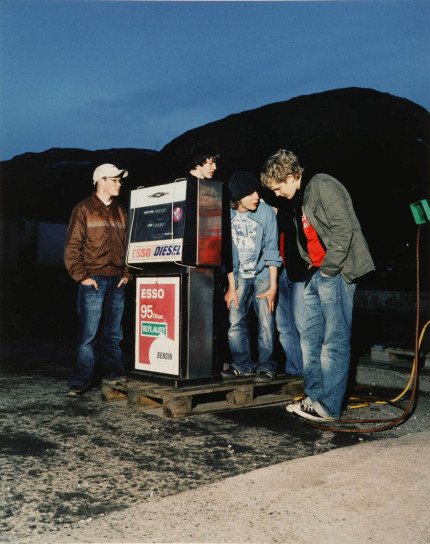
Rob Hornstra
Below is a link to a building practice borrowed from ancient Japan. There is again, something allegorical about this technique.
http://materiadesigns.wordpress.com/2009/12/27/shou-sugi-ban-terunobu-fujimori-charred-cedar-siding/
The desire for ‘setting’ in today’s plays suggests a kind of determinism. From Shakespeare to Corneille, the description of location was minimal. There is an insecurity in demanding a set. Jan Kott’s essay on King Lear, and in particular, his analysis of the Mad Tom on the heath scene, remains critically important in understanding modern theatre. The place, the location of that scene is the stage. It can be no other.
A final note here, on the tragic death of Chokwe Lumumba. It does raise eyebrows, at least it does mine. But in any event, it is a sad day. And here is a link to the ever snide and patronizing Bhaskar Sunkara, with what pretends to be a eulogy, but is mostly an expression of his own reactionary conceits.
http://www.thenation.com/article/178546/chokwe-lumumba-revolutionary-end#
The Le Corbusier photo is from the Charnal House blog.

Stuart Brisley

John, you are connecting a number of important dots here, it seems to me. The “realness” of actors on film-TV is particularly provocative in its implications – True Detective is only making explicit the ghoul-work of the “industry” in general. And the political implications of this.
I have to say it is totally remarkable to see how comfortable people are defending some supposedly liberationist agenda by trotting out ethical judgments that are based on the exact same presuppositions that have created the Sixth Great Extinction we are currently, as a species, enacting. Slightly less surprising is how devoted we mostly are to the avoidance of any glance in the direction of the killing fields…but of course it will engulf us.
so much to say but first see this tv dummheit on stage
http://allthewaybroadway.com/ ‘it’s not personal, it’s just politics”
There is so much to respond to but I ewanted to bring up that L:BJ stage piecem starring Walter White really, less than Cranston…Is it precisely this that is required as explanation? That you fit the new into the library of shit and shlock? LBJ Breaking Bad – the new work of art positions itself as a tumor on the old piece of shlock BUT this also colonizes history with these shlock paradigms and motifs. Breaking Bad LBJ is Inglourious Basterds. It is curious to compare to Stalingrad which does use all the visual crap …the cgi and the videograme violence with the slomo-hover pause- hyperspeed blows of bayonet etc… but hooks it onto an old fashioned melodrama with some dialogue that is almost chekovian and a real politics. And that’s an interesting artifact because the loss of conception of space that constitutes this faux space creation that is 3D
of course the 3D looks like shit. It actually returns the screen to the artificiality of the moving backdrop of the 50s. It creates two planes one in front of the other rather than a three dimensional volume/ The forefronted effects are just absurd and distracting. But watching Stalingrad makes you notic eparticularly how the melodrama itself is creating space that the battle videograme visuals destroy.
And yes now you have put it there one can see how Sunkara’s bogus eulogizing Lumumba flattens, crushes the three dimensionality of history into the flat panels of cartoons and logos. The Jacobin mag logo heralds this too – it is not Emory Douglass, or Stenbergs, but a kind of abstraction that destroys space instead of edging it, like a commerical logo
@guy……thanks guy. And yes, I think the quesiton of the actor in film and on stage can be a useful discussion. Like Von Kleist’s essay on marrionete theatre updated.
@Molly. Yes, thats an astute remark about Sunkara…….flattening history. Its 3D spectacle history. Cartoon. Non integrated. Its almost a borderline personality history. And this brings up something I want to write about next time and that is a sense I get of ever more shrunken fictional worlds. Either its a spacecraft….Gravity or Battlestar Gallectica or star trek or whatever, where the suggestion is SPACE….infinite space, when in fact these worlds are very very closed and humanity means a few thousand people. Oh they talk about galaxies, but really, thats just a digital effect…a orb hanging in CGI space. The same with zombie films. Its a very closed world of a few people. Masses are treated with signifiers. With abstraction. And sometimes not even that. And things seem to be closing in even further as we go along. So if you have a Beckett or Kafka say, writing of alienation, and isolation, it is posited against the reality of there being an off stage. Today, there is no offstage but they act as if there is and its referred to…even though its not there. I have to think more on this, but as for 3D, its headache inducing, too. Its also related, somehow, to my autism theory. Background and foreground as you suggest. The reading of 3D is done very oddly by everyone I think, but im not sure exactly how.
I have to say I did not immediately notice what the subtext of the Sunkara piece was. Which is shocking, I know, but it is so conventional in its wrongness that I just didn’t hear what he was really saying.
Great points here. I completely agree with the “vastness” evoked by flat surfaces. I keep hearing how beautiful and “stunning” the slow shots of sunrise/aurora/etc. in Gravity was, how “artistic”, when really it’s just a brochure quality level of art. Travel ads. But that passes for beauty nowadays. I mean has nature ever seemed so chrome? Compared with the silence of 2001, what stands out about Gravity is its non-stop chatter. “I love the silence of space”, and then she went on narrating the plot pointlessly for the audience.
I mean I can’t believe no reviewer pointed out the basic lack of craft in the screenplay. “We’ve got 7 minutes”, she says, as she looks at her watch that says “7:00”. “The debris is coming. That’s bad,” she says, as the camera shows the debris coming.